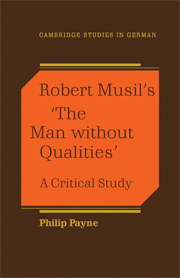Book contents
- Frontmatter
- Contents
- Preface
- A note on the translation of quotations and on references
- Part I Aspects of Musil's life and works
- Part II ‘The Man without Qualities’
- 4 Introduction
- 5 A critical approach to the structure
- 6 An investigation of two major themes
- 7 Moosbrugger – a study in applied subjectivity
- 8 Ulrich as ‘Man without Qualities’
- 9 Review of The Man without Qualities from the perspective of the narrator
- 10 Ulrich and Agathe
- Epilogue
- Notes
- Bibliography
- Index
6 - An investigation of two major themes
Published online by Cambridge University Press: 04 August 2010
- Frontmatter
- Contents
- Preface
- A note on the translation of quotations and on references
- Part I Aspects of Musil's life and works
- Part II ‘The Man without Qualities’
- 4 Introduction
- 5 A critical approach to the structure
- 6 An investigation of two major themes
- 7 Moosbrugger – a study in applied subjectivity
- 8 Ulrich as ‘Man without Qualities’
- 9 Review of The Man without Qualities from the perspective of the narrator
- 10 Ulrich and Agathe
- Epilogue
- Notes
- Bibliography
- Index
Summary
‘Wirklichkeit’
The most revealing feature of ‘Wirklichkeit’ (reality'), from Musil's point of view, is the point where the objective and the subjective touch. Musil concentrates on the ways in which individuals see and interpret the outside world. In the narrative of The Man without Qualities many points of view are recorded, and all are human and partial; Musil does not try to see as if through immortal eyes. Musil's ‘Wirklichkeit’ is a co-operative venture which involves the full cast of characters he presents, each contributing his or her individual mental operations to the joint enterprise of a representation of Viennese ‘Wirklichkeit’. The work moves from the viewpoint of one character to another, or ascends or descends within a character's mind from one level of consciousness to another. These movements are all so clearly articulated that it seems that Musil deliberately left traces of his ‘Gedankenexperiment’ in the finished text, just as in some paintings the marks of the artist's brush are clearly visible. By thus revealing to his readers something of the novelist's craft Musil intended to encourage them to think critically about the kind of evidence which anyone considers when speculating about how another thinks and feels.
Thus it might seem from this perspective that Musil's version of Viennese ‘Wirklichkeit’ in The Man without Qualities was merely Diotima's ‘Wirklichkeit’, plus Arnheim's ‘Wirklichkeit’, plus Leinsdorf's ‘Wirklichkeit’ and so on through the full ‘cast’ of characters in the text.
- Type
- Chapter
- Information
- Robert Musil's 'The Man Without Qualities'A Critical Study, pp. 85 - 113Publisher: Cambridge University PressPrint publication year: 1988



